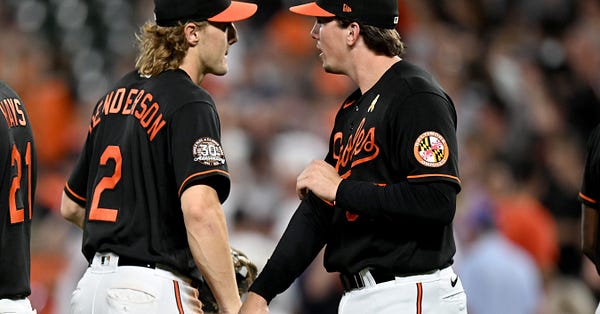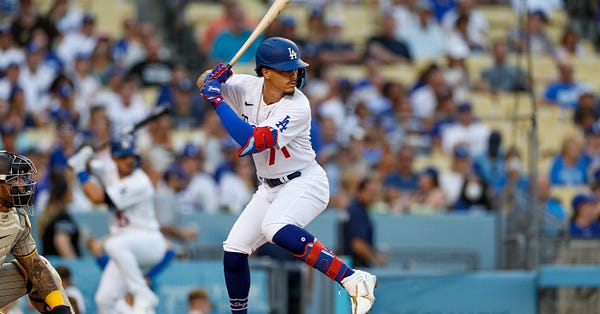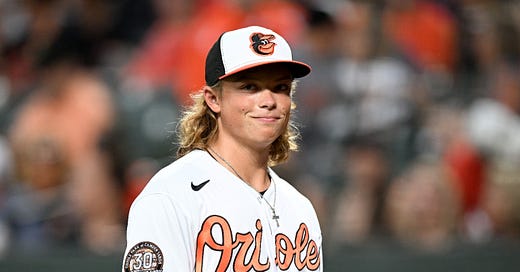Tuma’s 2023 FYPD Prospect Rankings for Dynasty Fantasy Baseball Leagues
Druw Jones or Jackson Holliday? When to draft Senga and Yoshida? Dalton Rushing worth reaching on?
Dynasty fantasy baseball leagues are heating up, which means many of us are prepping for First Year Player Drafts (FYPDs) to replenish our farm system and build our next championship winning squad.
The below ranks aren’t the deepest that you’ll find online — if you need a top 100 I recommend Baseball America ($). The reason I cut things off after 24 names is that we have such little data on these players, and it gets really hard to evaluate the 37th player versus the 56th. Differentiating between the 8th and 12th choice is much easier. I was able to put a lot more thought into each ranking below since I didn’t go too deep.
You’ll notice pitchers don’t rate too highly on my list. That’s partly due to this being a weaker pitching class, but also because I’m in favor of building dynasty teams through position players first.
I also occasionally give a bump in the rankings to players on big market teams (since this can speed up the hype cycle) and prospects in organizations with strong track records of player development. Again, we know such little about these players and as a tiebreaker I’m going to bet on franchises who seemingly get the most out of their minor league talent.
Lastly, position-by-position dynasty ranks, my top 50 overall prospects with notes, and macro-level dynasty strategies can be all be found on Patreon for subscribers here (just $5). And reach out on Twitter anytime, @toomuchtuma.
1. Jackson Holliday, SS, Orioles
As mentioned I recently completed my top 50 prospect rankings and I struggled with Holliday and Jones. At first I had Holliday ahead by one spot. Then I went back and read Jones’ post-draft write-ups and moved him back up. Now I’m going back to Holliday.
For starters, Holliday posted a 25:12 BB:K ratio in his pro debut last summer. Some of that came at the Florida Complex League, but he also had 15 walks against 10 strikeouts at Low-A, as an 18-year-old!
Holliday checks the boxes of my two favorite skills — hit tool and strike zone discipline. He still has physical projection remaining. He’s the son of a former big leaguer, set the national record for hits by a high school player this past spring, and is already showing out in pro ball. I consume as much MLB Pipeline and Baseball America content as I can handle. The praise for Holliday is through the roof.


2. Druw Jones, OF, D’Backs
Jones was the top ranked player in the 2022 draft and it’s entirely unfair to drop him from the first spot in FYPDs just because he hurt his shoulder and didn’t debut last summer. He did nothing to “lose” the No. 1 spot.
And yet, in my eyes, Holliday did enough to usurp him. Don’t let this ranking be any sort of knock on Jones, though. Jones is awesome and this is really a 2-player draft. There’s a tier drop immediately after these two and I’m more than fine with anyone who prefers taking Druw with the 1.01 pick.
Rotowire’s James Anderson recently described Jones’ upside as being a durable Byron Buxton who doesn’t stop running. I love that comp. Part of Jones’ appeal to major league teams was his elite work in center field as an amateur and double-plus speed. I’d like to see him work on his in-game lift (elevating the ball as a hitter) once he gets to Low-A, but that isn’t rare for long-limbed prep bats.
3. Kodai Senga, SP, Mets
I’d take Holliday and Jones with the top 2 picks even if I had a contending team. Then I’d take Senga. However, if someone isn’t contending and has this decision at the 1.03, then you should lean towards Johnson or Green over the 30-year-old arm.
In NPB last season Senga compiled a 1.94 ERA with a 156:49 K:BB in 144 innings. He has a fastball that reaches triple digits and a splitter that gives him two plus offerings. We don’t know what the shape of his four-seamer is like, however, and I’ll feel a lot better about my Senga evaluation once we get some Stuff+ numbers on him via Eno Sarris.
Something else to keep in mind with Senga is whether or not the Mets will use a 6-man rotation to accommodate him? Or will they skip starts and/or piggyback some other pitchers? Even with these unknowns he’s an incredibly safe FYPD choice.
4. Termarr Johnson, 2B, Pirates
Johnson is known for having one of the best amateur hit tools ever. Scouts during the pre-draft process compared his bat-to-ball skills to Vladimir Guerrero Sr. In addition to pristine bat control, Termarr is able to quickly identify strikes and punish them.
He has an interesting build in that he’s short yet already physically maxed out, so the hit tool is going to need to carry the entire profile. If he sticks at 2B it’ll help fill a weak position in dynasty leagues. On the other hand, I wish I felt better about Pittsburgh’s player development. It isn’t enough for me to move off of him as a top-4 FYPD choice. Johnson faced weak competition in high school and will need to prove he can handle premium velocity and off-speed pitches as a pro.
5. Elijah Green, OF, Nationals
It was only a 52 plate appearance sample but Green’s 40.4 K% from the Florida Complex League is hyper concerning, particularly because swing-and-miss was a worry for him coming out. I’m willing to look past it due to the fact he was 18 and again the sample was just so small.
Green is an outlier athlete who has the power to hit the ball out of any park, to any field, while flashing elite speed. He might’ve had the best tools for a draft eligible player since Bryce Harper. Green combines with James Wood to give the Nationals two highly volatile, high-upside outfield prospects. Just monitor the strikeout rate as he advances to Low-A in 2023.
6. Masataka Yoshida, OF, Red Sox
Chaim Bloom surprised the baseball world by handing Yoshida a 5-year, $90 million contract whereas some executives didn’t think he was worth half of that. Agent Scott Boras noted Bloom moved with conviction on this signing, citing his model as part of the reason Bloom felt strongly about the 29-year-old.
Whatever model Bloom is using, it must operate similarly to the projection systems publicly available on Fangraphs. THE BAT X pegs Yoshida for a .283/.365/.459 line, good for a 129 wRC+. Steamer projects him to slash .298/.388/.479 while being 40% better than league average.
These data points are encouraging, but Yoshida still has a wide range of outcomes in his first season with the Red Sox. He’s an obvious candidate to move up FYPD boards if a contending dynasty squad has a top pick.
7. Brooks Lee, SS, Twins
Lee is a switch-hitter who tore up the Cape Cod League in 2021 and became the best pure college bat in last year’s draft. There’s no guarantee he stays at shortstop and he’s had some back issues, but otherwise this is a safe, projectable middle infielder we won’t have to wait too long on.
8. Cam Collier, 3B, Reds
Conversely, Collier drafters are going to need to be patient. He was the youngest hitter in the ‘22 draft out of Junior College. The last Round 1 JUCO bat was Tim Anderson in 2013. Collier was taken 18th overall last summer, but he was given the 10th largest signing bonus.
Believing in Collier is more of a scouting take than a statistical one as of now. He has a smooth swing with excellent hands and a hit-over-power approach, though he has long-term power potential too. Collier is so advanced for his age but similarly to Termarr Johnson he’ll need to keep hitting every step of the way.
9. Zach Neto, SS, Angels
The No. 13 overall pick has been one of the biggest FYPD risers post-draft. Neto reached Double-A (!!) by the end of the summer and hit .320/.382/.492 with 4 HR and 4 SBs in 30 games! He has an unorthodox swing but makes it work. The Angels have been aggressive with prospects in recent years, which has sometimes really hurt them (Jo Adell), but it seems like they’re fast-tracking Neto too. If your dynasty squad needs more immediate production in the middle of Round 1 there’s a case for taking him over Collier.
10. Kevin Parada, C, Mets
Parada followed in the rich catcher tradition of Georgie Tech — Jason Varitek, Matt Wieters, Joey Bart, etc. He’s seen as a future plus hitter with above-average power, though there’s some risk he doesn’t stick behind the plate. Scouts note he consistently gets into a good launch position despite an unorthodox setup. Overall, he’s a productive college hitter whose bat could be ready for the majors before his glove.
11. Dalton Rushing, C, Dodgers
Outside of the top 6 in my ranks, Rushing is my favorite FYPD pick. He fell to the Dodgers in the 2nd round because he spent most of his collegiate career backing up 2021 No. 1 overall pick Henry Davis at Louisville, but it turns out he might also be really, really good.
Rushing reached Low-A by the end of last summer and hit .424/.539/.778 (!!) with 8 homers, a 16.4 BB%, and a 16.4 K%. Clearly the level was too easy for him, but I love the dominance. Furthermore, he’s going to receive the “Dodgers shine” for being part of this organization.
Of course, LA has Will Smith under contract for 3 more season and Diego Cartaya waiting in the wings, so Rushing is pretty blocked at the moment. For now, draft the talent and worry about the rest later. It’s hard to make the case for Rushing over the Lee-Parada range of picks, but I’d be ecstatic to land him at the back end of Round 1 FYPDs.


12. Spencer Jones, OF, Yankees
The Vanderbilt product possesses plus-plus raw power and also surprising speed. As expected, his exit velocities and hard-hit rates backed up the scouting reports. There’s serious risk when it comes to making contact, but of course the profile comes with considerable upside too. If Jones pans out then his Yankee ties will make him an even bigger deal than he otherwise would be.
13. Chase DeLauter, OF, Guardians
The perk of picking towards the end of Round 1 in FYPDs this year is that there’s a lot of college bats available. DeLauter has a small conference background (James Madison), but he has contact ability and zone recognition skills.
Model focused organizations, which the Guardians are, liked DeLauter for his exit velocities, age, and strong performance in the 2021 Cape Cod League. DeLauter’s stance isn’t for everyone but the production will be if he keeps it up. He’ll make his pro debut in 2023 after missing the end of the year due to injury.
14. Jett Williams, SS, Mets
Williams’ insertion into this portion of the ranks breaks up all the college bats. Whereas DeLauter is an analytical play, Williams’ value rests in his scouting grades. The No. 14 overall pick from last July has drawn comps to Alex Bregman and Dustin Pedroia for playing with a chip on his shoulder. His game features bat-to-ball skills, plus speed, and an overall exciting style of play. Watching him for a few games it’s easy to see why scouts become enamored with him.
15. Drew Gilbert, OF, Astros
Cross (below) is probably a more accomplished player than Gilbert but it’s close and I’d just rather bet on the Astros than the Royals. Gilbert was taken 28th overall out of Tennessee and is a high-energy player who manages the strike zone while barreling up the ball consistently. He profiles as a top of the order bat.
16. Gavin Cross, OF, Royals
Cross, meanwhile, is a well-rounded outfielder without many weaknesses. He has an above-average hit tool, knowledge of the strike zone, and above-average power. The No. 9 pick out of Virginia Tech reached Low-A at the end of last summer.
17. Cade Horton, SP, Cubs
Horton’s stock sky rocketed leading up to the 2022 College World Series. He began the season as a reliever and was trying to learn a cutter early on. This led to the development of his slider, which helped him dominate just as the draft was approaching.
Horton wound up as the No. 7 overall pick, featuring a power arsenal that overwhelms opposing hitters. He has a fastball that features natural ride and cut, and a hard, vertical slider. There’s a debate out there whether the Cubs bought high (immediately after the CWS) or bought low (they got him on an under-slot deal). I like what Chicago has done pitching wise lately and am more in on Horton than out.
18. Cooper Hjerpe, SP, Cardinals
Hjerpe was the 22nd overall pick out of Oregon State and features a deceptive, lefty arm slot. His fastball grades out well analytically due to its unique characteristics (the shape of it and his outlier approach angle). Hjerpe also projects for more power than your typical sidearmer.
19. Justin Crawford, OF, Phillies
The son of Carl Crawford possesses double-plus speed just like his dad. Taken 17th overall, he’s a pure upside play at this point in drafts. A toolsy prep hitter with a surplus of athleticism like you’d expect, Crawford’s game is perfectly suited for fantasy baseball if he develops like the Phillies hope he will.
20. Jacob Berry, 3B, Marlins
At one point last spring Berry was in play to be the top overall pick, but he wound up as a bit of a disappointing No. 6 overall selection by the Marlins.
MLB Pipeline referred to Berry as a switch-hitting Andrew Vaughn during the pre-draft process. He can hit for average, power, and draw plenty of walks. His game is otherwise limited and Miami’s offensive environment could suppress his biggest strengths.
21. Dylan Lesko, SP, Padres
A prep right-hander out of Georgia, Lesko was viewed as the best arm in the 2022 draft class before undergoing Tommy John surgery in April. Padres GM AJ Preller pounced with the 15th overall pick, hoping to buy low on a double-plus fastball/changeup combo (with a plus curve as well).
Dynasty managers who take the plunge on Lesko will have to be patient as he works his way back from TJ and then goes through the slow-burning development of high school arms entering the pro game. At a certain point in FYPDs Lesko presents enough of a ceiling to roll the dice on.
22. Jace Jung, 2B, Tigers
The brother of Rangers 3B Josh Jung, Jace’s scouting report is that he has more power at the same age, but is less well-rounded. He also has less defensive value and his best position has been described as the batter’s box.
The younger Jung is known for an old school approach of hitting the ball where its pitched. He has always produced and has a good knowledge of the strike zone. If he sticks at 2B it’ll help fill out a weak position for dynasty managers.
23. Mikey Romero, SS, Red Sox
The Red Sox took a pure hitting, lefty swinging shortstop from Southern California in Round 1 for the second straight draft. This might be the highest you see Romero in FYPD rankings, and it reflects my preference for investing in hit tools. Romero ultimately projects as a table setting middle infielder. His supplemental tools are more average than plus, but the sum of the parts could produce a future big leaguer. Fenway is a strong offensive environment, and it would pair well with Romero’s sweet swing.
24. Kumar Rocker, SP, Rangers
A buzzy name to close out the first 2 rounds of a theoretical 12-team FYPD. You know who Rocker is, and depending on which reports/stories you’ve read lately this ranking might feel way too low or way too high.
There were serious concerns about Rocker’s performance in the Arizona Fall League. His windup was stiff and he threw from a lower arm slot, reportedly to ease the stress on his shoulder. It’s unclear if that should be considered a good thing. I’m glad he’s protecting himself, but it’s worrisome he had to at all.
Scouts noted that his slider showed flashes of being the dominant pitch that turned him into an elite prospect. That’s good, but it’s presently tough to envision Rocker rising back up the SP prospect ranks.
Honorable Mentions
Brock Porter, SP, Rangers
Cole Young, SS, Mariners
Daniel Susac, C, A’s
Brandon Barriera, SP, Blue Jays
Ethan Salas, C, Padres




